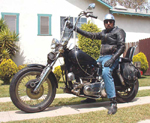
|
|
|
I'll admit it, I've never been a sports fan. Many, many moons ago, back in the 60s when Sandy Koufax was with the Dodgers here in L.A., the World Series actually managed to attract a wee bit of my attention. In 1984, when the Olympics came to town, I went out to observe the spectacle of the global media spotlight pass directly in front of me down the center of familiar streets. That's about it. So it's difficult for me to fathom the rationale for sports riots, especially when you're wrecking your own home town. Even more remarkable is the fact that these riots can occur both when local teams lose or win major games! My suspicion is that much of the time the riots themselves are simply convenient excuses for looting and other mayhem, but I've never studied the topic, so perhaps there are deep psychological reasons for such abominable mob behavior, of which I'm unaware. The recent riot in Vancouver, Canada following a Stanley Cup loss has now triggered a number of controversies relating to social media and facial recognition systems. Word is that law enforcement personnel are using social media like Twitter and Facebook to try identify rioters, and now we've heard that The Insurance Corporation of B.C. is offering the use of its facial recognition software to try match looters via a database of driver's license and ID card photos. Recently, in Weiner, Whiners, and Social: Public Means Public!, I suggested that attempting to restrict access to data that is already publicly online just doesn't usually make sense. In More on Google "Search by Image" and Facial Recognition Realities, I addressed some other related issues. When it comes to which photos or data are reasonable fair game for authorities to use in situations such as that in Vancouver, it can help to break the matter down into several categories. Photos and such that are already public seem like (if you'll excuse the sports metaphor) a slam dunk. This is clearly the case when the parties involved posted the images themselves. From a functional standpoint, if someone else posts relevant photos publicly, the bottom line seems pretty much the same. Public is public. The legal situation seems hazier when photos are restricted to particular "friend" groups and similar circles. If authorities interested in seeing such photos request to become a "friend" for that reason alone and misrepresent themselves, the legal issues could become quite significant, and possible violations of sites' Terms of Service agreements would also come into play. On the other hand, since any "friend" with access to the photos could turn around and re-post them publicly (whether legally or not), what was once restricted could easily undergo a status change that might be difficult to fight in a practical sense once it's out there. As always when it comes to social media, the best rule of thumb is not to post materials -- even to a restricted group -- that you'd be uncomfortable having go public if someone in your group purposely or accidentally leaked it. And let's face it, sometimes there are photos that probably should not exist in the first place. If you think you're going to be concerned some day by that party shot of you tied naked to the bed next to a bottle of Woolite, perhaps the camera shouldn't have been brought out at all that night. The controversy over the use of driver's license/ID databases in conjunction with facial recognition systems in Vancouver would seem to revolve almost entirely around the specific laws in place controlling access to and use of that specific data for broad identification scanning purposes. The taking and filing of these images are not "optional" in any normal sense for the population of Vancouver, and would hopefully have been gathered within a detailed context of legitimate uses. As facial recognition technology improves, and authorities seek to employ these systems in much the same way they would treat crime scene fingerprints and fingerprint databases, it is crucial that all rules be strictly followed, rights respected, and citizens be made aware ahead of time if their facial imagery has morphed into the same law enforcement league as fingerprints or DNA. Facial recognition systems haven't reached the level of accuracy generally associated with "physical contact" biometrics usually used by authorities today -- at least not yet. But some advanced facial recognition systems and related technologies are already considerably more accurate than most people realize, and they will be getting even better -- much better. This entire spectrum of systems, including facial recognition, will be engendering an array of complexities that go far beyond the sports riots in Vancouver. We can be sure that these technologies -- all of which have legitimate, worthwhile uses -- will not be successfully suppressed. So we really do need to learn not only how to live with them, but how to use them wisely and appropriately. And the sooner that we can come to terms with that, the better. --Lauren-- |
Posted by Lauren at June 18, 2011 07:24 PM
| Permalink
Twitter: @laurenweinstein
Google+: Lauren Weinstein